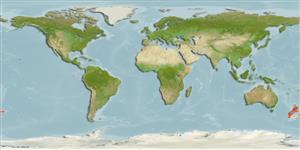Common names from other countries
Classification / Names / Names
ماع يماسا | فدارتم | Catalog of Fishes (gen., sp.) | ITIS | CoL | WoRMS
Environment: milieu / climate zone / depth range / distribution range
يسانش موب
یز حطس; قمع تارييغت 0 - 500 m (Ref. 275). Temperate, preferred 16°C (Ref. 107945); 39°S - 56°S, 165°E - 176°W (Ref. 120902)
Southwest Pacific: New Zealand; Known from the South Island, the southeast coast of the North Island, also from south of the Auckland Island and west to the Chatham Islands.
Length at first maturity / Size / Weight / نس
Maturity: Lm ? range ? - ? cm Max length : 42.0 cm ML يسنج صاوخ نودب / رن سنج; (Ref. 275); هدش شرازگ نزو هنيشيب: 1.8 kg (Ref. 275); هدش شرازگ نس هنيشيب: 1.00 اه لاس (Ref. 127344)
Life cycle and mating behavior
غولب | لثم دیلوت | یزیر مخت | اه مخت | Fecundity | )ورال ( دازوت
Members of the class Cephalopoda are gonochoric. Male and female adults usually die shortly after spawning and brooding, respectively. Mating behavior: Males perform various displays to attract potential females for copulation. During copulation, male grasp the female and inserts the hectocotylus into the female's mantle cavity where fertilization usually occurs. Life cycle: Embryos hatch into planktonic stage and live for some time before they grow larger and take up a benthic existence as adults.
یلصا ذخآم
عجارم | هدننك گنهامه | ناراكمه
Roper, C.F.E., M.J. Sweeney and C.E. Nauen. 1984. (Ref. 275)
NCUI زمرق تسرهف رد تيعضو (Ref. 130435)
ستياس رظن زا تيعضو (Ref. 108899)
Not Evaluated
Not Evaluated
یناسنا هدافتسا
تاليش – يريگ يهام: يراجت
FAO - تاليش – يريگ يهام: landings, هنوگ هيامن | FishSource | Sea Around Us
اهرازبا
يتنرتنيا عبانم
Estimates based on models
Preferred temperature
(Ref.
115969): 8 - 14.5, mean 11.8 (based on 53 cells).
یگدنهج
طسوتم, لاس 4/4 – 1/4 تيعمج ندش ربارب ود يارب مزال نامز هنيمك (K=0.25).
یريذپ بيسآ
Low to moderate vulnerability (32 of 100).
